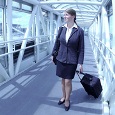
AAOS Offers Some Ergonomic Travel Safety Tips
The American Academy of Orthopaedic Surgeons (AAOS) has recommendations to help you carry your baggage safely as holiday travel season gets underway.
According to the U.S. Consumer Products Safety Commission, in 2007, more than 50,000 people were treated in hospital emergency rooms, doctors' offices, clinics, and other medical settings for injuries related to luggage.
Packing light may prevent injuries such as strains, pulls, and tears. Any of these injuries can occur while carrying a heavy suitcase for an extended period of time or from incorrectly lifting luggage from baggage claim carousels, overhead, or under-seat compartments.
The chances of these injuries are even greater when a person has been sitting still for a long period of time (as when on a plane) or when the luggage is over-packed and especially heavy.
"Using proper lifting techniques can ensure that your trip isn't cut short by an injury," said William R. Marshall, MD, an AAOS spokesperson and orthopaedic surgeon in Fort Walton Beach, Fla. "Even a relatively minor injury, such as a muscle pull, to the back, neck, or shoulders can be quite painful in the short term and end up ruining your vacation."
AAOS offers the following strategies to prevent injuries when lifting and carrying luggage:
- Pack lightly. When possible, pack items in a few smaller bags instead of one large luggage piece. It is better--and may prevent muscle sprains and strains--to carry a lighter bag in each hand rather than one heavy bag in one hand or over one shoulder.
- As with any heavy lifting, you should bend at the knees and lift luggage with your leg muscles--not your back and waist--and avoid twisting and rotating your spine. Stand alongside your suitcase, bend at your knees, then grasp the handle and straighten up. Also, try to carry luggage as close to your body as possible.
- When placing luggage in an overhead compartment, first lift it onto the top of the seat. Then, with the hands situated on the left and right sides of the suitcase, lift it up. If your luggage has wheels, make sure the wheel-side is set in the compartment first. Once wheels are inside, put one hand atop the luggage and push it to the back of the compartment. To remove the luggage, reverse this process.
- If using a backpack, make sure it has two padded and adjustable shoulder straps. Choose one with several compartments to secure various-sized items, packing the heavier things low and towards the center. Always wear a backpack on both shoulders--slinging it over one shoulder does not allow weight to be distributed evenly, which can cause muscle strain.
- If you need to use a duffel or shoulder bag, do not carry it on one shoulder for any length of time. Be sure to switch sides often, as this may prevent soreness and discomfort to the shoulder area.
Some other important tips:
- When purchasing new luggage, look for sturdy, light pieces with wheels and a handle. Avoid purchasing luggage that is too heavy or bulky while empty.
- Do not rush when lifting or carrying a suitcase. If it is too heavy or an awkward shape, ask someone for help.
- Do not carry heavy pieces of luggage for long periods of time. If it is very heavy and you must carry it, stop and take a break. If at all possible, check your luggage when traveling rather than carrying it on a plane, train, or bus.
- Make sure to carry all rolling luggage up flights of stairs.